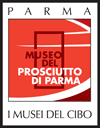In this fertile land delimitated to the North by the river Po and to the South by the Apennine peaks, between the rivers Enza and Stirone, since time remote herds of pigs have been raised facilitated by the vast forestlands and the presence of oaks and, thus acorns.
Langhirano
Pigs grazed in the vast woodland areas and the population of celtic origin which had settled there refined the ‘technology’necessary to use and preserve pork meat. Yet again the characteristics of the land played a vital role. Only here do the marine winds which are channelled through the Magra valley, dry and cleansed of their salt content thanks to the thick chestnut woods, arrive, today as yesterday, having crossed the high Apennines and descended to the soft hills and valleys which give onto the plain, permitting an exceptional maturing process, favouring the preservation of the salted pork products whether they be worked or conserved in pig bladder.
Only here are the spa towns of Lesignano and Salsomaggiore, where thermal salt rich in sulphur can be taken directly from the thermal springs which guarantees, thanks to the fact that less is needed, an optimum preservation of the meat and also its‘sweetness’. Only here do the dense, damp fogs of the lowlands or ‘Bassa’touched by the Po river, allow for the gentle maturing process of shoulders of ham (spalle) and culatte (a cut from the central part of the pig haunch) giving rise to authentic gastronomic masterpieces.
Only here has the art of cheese making connected with Parmigiano Reggiano allowed for the pigs to be fed with the first rate left-overs of the process involved in transforming milk into the King of Cheese.
So, not by chance then can this territory offer such a rich choice of excellent cured meat products, from the raw Parma Ham or Prosciutto to the Culatello from Zibello, the Salame of Felino and the cooked shoulder of ham or Spalla Cotta from San Secondo; the panorama of gastronomy in Parma boasts these products, champions of quality and sweetness, of well balanced nutrition and flavour. The Prosciutto of Parma Museum is dedicated to this inestimable patrimony, to the culture by which it has been generated, to its history and to the generations of people who have faithfully passed on its secrets.
Badia Cavana
Un’altra suggestiva architettura conventuale si trova a San Michele Cavana, a pochi chilometri da Langhirano, ma sull’altra sponda del torrente: Badia Cavana, un tempo chiesa di San Basilide. Fondata su una verde altura, intorno al 1111, da San Bernardo degli Uberti, vescovo di Parma dal 1109 al 1133, fu un’importante abbazia, appartenuta alla congregazione dei Vallombrosani fino al XV secolo. Quanto rimane del monastero è oggi una piccola e semplice chiesa d’impianto romanico, dedicata a San Michele. Restaurata nel 1842, conserva della struttura originaria il nartece, caratterizzato da notevoli capitelli in pietra arenaria con simboli degli evangelisti e intrecci vegetali, e il chiostro, che ha mantenuto la planimetria del XII secolo. Secondo la tradizione, nella cripta custodirebbe le spoglie di San Basilide.
To visit
Around Langhirano
Poco prima del paese di Langhirano, provenendo da Parma, si erge solitaria e imponente, come sospesa in un’atmosfera “senza tempo”, l’elegante mole del castello di Torrechiara “rocha altiera et felice”, dal cuore splendidamente affrescato. Fatto costruire fra il 1448 e il 1460 da Pier Maria Rossi come inespugnabile fortilizio militare a dominio della Val Parma, ma anche come nido d’amore per lui e Bianca Pellegrini (moglie di un nobile di Arluno, conosciuta alla corte di Milano) il castello è uno dei più importanti manieri medievali italiani, tra i più estesi e meglio conservati.
Lievi colline, grandi vallate verdi e campi coltivati con cura. È la valle formata dal torrente Parma, che risale dall’alta pianura a sud della città fino all’Appennino, e che accoglie il paese di Langhirano, l’architettura conventurale di San Michele Cavana, il castello e la badia di Torrechiara.









